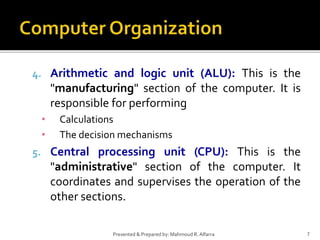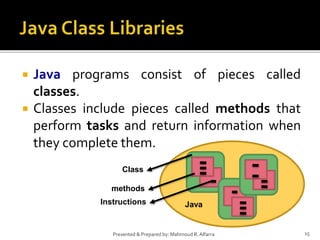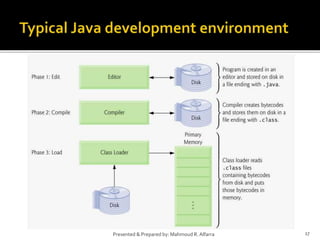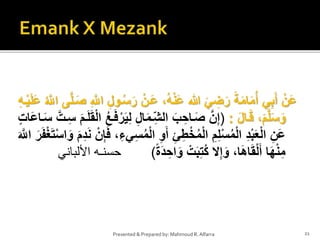3 programming-using-java introduction-to computer
- 1. Using Java MINISTRY OF EDUCATION & HIGHER EDUCATION COLLEGE OF SCIENCE AND TECHNOLOGY KHANYOUNIS- PALESTINE
- 2. What is computer? Computer Organization Programming languages Java Class Libraries Typical Java development environment Case Study: Unified Modeling Language Emank X Mezank 2Presented & Prepared by: Mahmoud R. Alfarra
- 3. A computer is a device capable of performing computations and making logical decisions at speeds millions (even billions) of times faster than human beings can. Computers process data under the control of sets of instructions called computer programs. 3Presented & Prepared by: Mahmoud R. Alfarra
- 4. A computer consists of various devices referred to as hardware. e.g.: The keyboard. Screen. Mouse. Disks … The programs that run on a computer are referred to as software. 4Presented & Prepared by: Mahmoud R. Alfarra
- 5. computer may be envisioned as divided into six logical units : 1. Input unit. This is the "receiving" section of the computer. It obtains information from input devices and places this information at the disposal of the other units so that it can be processed. 5Presented & Prepared by: Mahmoud R. Alfarra
- 6. 2. Output unit. This is the "shipping" section of the computer. It takes information that the computer has processed and places it on various output devices to make the information available for use outside the computer. 3. Memory unit. This is the rapid-access, relatively low-capacity "warehouse" section of the computer. 6Presented & Prepared by: Mahmoud R. Alfarra
- 7. 7Presented & Prepared by: Mahmoud R. Alfarra 4. Arithmetic and logic unit (ALU): This is the "manufacturing" section of the computer. It is responsible for performing • Calculations • The decision mechanisms 5. Central processing unit (CPU): This is the "administrative" section of the computer. It coordinates and supervises the operation of the other sections.
- 8. 6. Secondary storage unit. This is the long-term, high-capacity "warehousing" section of the computer. 8Presented & Prepared by: Mahmoud R. Alfarra
- 9. Programming languages may be divided into three general types: 1.Machine languages 2.Assembly languages 3.High-level languages 9Presented & Prepared by: Mahmoud R. Alfarra In two pages, write what is algorithm, why and how do they represented ?HW 2.1
- 10. Any computer can directly understand only its own machine language. It is defined by the computer hardware design. Machine languages are machine dependent (i.e., a particular machine language can be used on only one type of computer). 10Presented & Prepared by: Mahmoud R. Alfarra
- 11. Machine languages generally consist of strings of numbers (0,1). So, It was simply: Too slow Tedious for most programmers 11Presented & Prepared by: Mahmoud R. Alfarra
- 12. Programmers began using English-like abbreviations to represent elementary operations. These abbreviations formed the basis of assembly languages. 12Presented & Prepared by: Mahmoud R. Alfarra
- 13. Translator programs called assemblers were developed to convert early assembly- language programs to machine language at computer speeds. 13Presented & Prepared by: Mahmoud R. Alfarra Assembly instructions Assemblers Machine instructions Assemblers
- 14. To speed the programming process, high-level languages were developed in which single statements could be written to accomplish substantial tasks. Translator programs called compilers convert high- level language programs into machine language. 14Presented & Prepared by: Mahmoud R. Alfarra high-level languages Compilers Machine instructions Compilers
- 15. Java programs consist of pieces called classes. Classes include pieces called methods that perform tasks and return information when they complete them. 15Presented & Prepared by: Mahmoud R. Alfarra Java Class methods Instructions
- 16. 16Presented & Prepared by: Mahmoud R. Alfarra The collections of existing classes in the Java class libraries, are also known as the Java APIs (Application Programming Interfaces).
- 17. 17Presented & Prepared by: Mahmoud R. Alfarra
- 18. 18 Presented & Prepared by: Mahmoud R. Alfarra
- 19. 19Presented & Prepared by: Mahmoud R. Alfarra UML: a graphical language that allows people who design software systems to use an industry standard notation to represent them. Study the case study from the text book of the course, section 1.16HW3.1
- 20. Fill in the blanks in each of the following statements: 1. The logical unit of the computer that receives information from outside the computer for use by the computer is the __________. 2. The process of instructing the computer to solve a problems is called ________. 3. __________ is a type of computer language that uses English-like abbreviations for machine-language instructions. 4. __________ is a logical unit of the computer that sends information which has already been processed by the computer to various devices so that it may be used outside the computer. 5. __________ and __________ are logical units of the computer that retain information. 6. __________ is a logical unit of the computer that performs calculations. 7. __________ is a logical unit of the computer that makes logical decisions. 8. __________ languages are most convenient to the programmer for writing programs quickly and easily. 9. The only language that a computer can directly understand is that computer's __________. 10. __________ is a logical unit of the computer that coordinates the activities of all the other logical units. 20Presented & Prepared by: Mahmoud R. Alfarra Solve the following practice… HW3.2
- 21. َر َْننع ،ُهْنَع هللا َي ِضَر َةَماَمُأ يِبَأ َْنعُ َِّلله اِىنََ ِ َِّلله ِِنلُسِهنْيَىَع َِناَق ،َمِىَسَل:(ِِاَمنِِّ َّللش ََ ِِناََ ِنِإِ نِس َمنَىََْشَّلل ُُنَفْرَيِشَاعناَس َّلل ِلَأ ِئِطْخُمْشَّلل ِمِىْسُمْشَّلل ِدْبَعْشَّلل َِنعْسَّللَل َمِدَن ْنِإَف ،ِيءِسُمْشَ َِّلله َرَفْغَت َةد َِِّللَل ْ َبِتُك الِإَل ،اَهاََْشَأ اَهْنِم)األلباني حسنـه 21Presented & Prepared by: Mahmoud R. Alfarra
- 22. Main concepts of Programming 22Presented & Prepared by: Mahmoud R. Alfarra






















